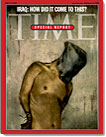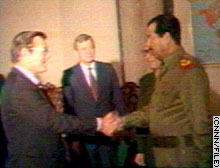WASHINGTON, Aug. 28 - A Central Intelligence Agency review that grew out of the furor over abuses at Abu Ghraib prison now includes scrutiny of the agency's interrogation and detention practices at military-run facilities and other sites across Iraq, government officials say. C.I.A. Expands Its Inquiry
Into Interrogation TacticsBy DOUGLAS JEHL and DAVID JOHNSTONThe reassessment, which is more far-reaching than previously known, could have implications for the agency's conduct elsewhere, including interrogations of high-level Al Qaeda suspects like Khalid Shaikh Mohammed who are being held by the C.I.A. in secret facilities around the world.
Former intelligence officials say that lawyers from the C.I.A. and the Justice Department have been involved in intensive discussions in recent months to review the legal basis for some extreme tactics used at those secret centers, including "waterboarding," in which a detainee is strapped down, dunked under water and made to believe that he might be drowned.
"Policies and procedures on detention interrogation in Iraq and elsewhere have been the focus of intense oversight and scrutiny, and very close attention has been paid to making them lawful," a senior intelligence official said on Friday.
Over all, the review by the intelligence agency, along with the investigations and corrective steps already undertaken by the military, reflect how the government has retreated from an aggressive posture adopted in the months after the Sept. 11 attacks on how far interrogators could go in questioning detainees.
Within the military in particular, some of the harsh procedures authorized until this spring were quickly suspended or abandoned after the extent of the abuses at Abu Ghraib surfaced in April. This week, reviews completed by two investigative panels have called for even clearer rules to be drafted for the military and intelligence agencies to require humane treatment during interrogation.
Among the questions raised by the Pentagon reviews is whether intelligence agencies should be required to heed the same guidelines for interrogation as the military, or whether they should be permitted more latitude. A report by Maj. Gen. George R. Fay about the abuses at Abu Ghraib said the conduct of C.I.A. personnel at the prison was perceived by military officials there as more aggressive than that allowed by the military. The report said the C.I.A.'s conduct had a corrupting influence on military interrogators and contributed to a view among them that it was permissible to exceed strict guidelines for interrogations.
Mark Mansfield, a C.I.A. spokesman, would say only that the agency's inspector general is conducting "several" reviews of the agency's conduct in Iraq. Mr. Mansfield said it had not yet been determined when the inquiries would be completed or whether the results of the probes would be made public.
Among the reviews, intelligence officials say, are an examination of what a military investigation described as eight "ghost" detainees who were incarcerated at Abu Ghraib, but who were kept off the prison's roster at the C.I.A.'s request. In one of those cases, in November 2003, a detainee brought to the prison by C.I.A. employees but never formally registered with military guards died at the site, and his body was removed after being wrapped in plastic and packed in ice.
The man had been detained by Navy Seals, who had hit him in the head with a rifle butt during his arrest, and the military investigation said that blow apparently led to his death. But the investigation suggested that the detainee might have survived if he had been screened by doctors, as would have been required had he been properly registered with the military.
The reviews have stirred concern in intelligence and military circles by officials who fear that decisions to forbid all coercive interrogation techniques could cost the United States valuable intelligence. A senior Army official, discussing new rules adopted by the military in a briefing for reporters on Wednesday, said the restrictions had damaged efforts to obtain information.
"Interrogators and detainees both know what the limits are," the official said. "They know that if the United States captures them, they will get a medical exam. They'll get their teeth fixed. They will get essentially a free physical and they will be released if they don't talk after a certain amount of time."
In interviews in recent days, some current and former intelligence officials have warned of the danger of showing too much deference to detainees who espouse extreme anti-American views.
"Let's keep in mind what the objective is - to get information that will save American lives," said a senior intelligence official. "And there is an absolute necessity to use effective interrogation to gain insights on plans to kill Americans."
Interrogations of suspected Qaeda figures including Mr. Mohammed, regarded as the mastermind of the Sept. 11, 2001, attacks, have been described by the independent commission that investigated those attacks as having provided rich and important information about terrorist operations. Intelligence officials have not spelled out in any detail the kinds of interrogation tactics used on Mr. Mohammed, but they have expressed concern that he has successfully resisted their efforts to extract information.
An April 2003 C.I.A. report on Mr. Mohammed that is cited in a footnote to the Sept. 11 commission's report refers in its title to Mr. Mohammed's "Threat Reporting - Precious Truths, Surrounded by a Bodyguard of Lies.''
In recent weeks, current and former officials say, the debate about interrogations and about Mr. Mohammed in particular has been conducted against the real and urgent backdrop of concern about a potential new terrorist attack.
Mr. Mohammed's knowledge of Qaeda personnel has become significant again because of his association with the suspected Qaeda figure known as Issa al-Hindi, or Dhiren Barot, who was among eight men arrested early this month in Britain and later charged with terrorist related offenses. The authorities believe that Mr. Hindi traveled to New York in 2000 and 2001 to conduct surveillance operations at five financial institutions in New York, New Jersey and Washington.
In the Sept. 11 commission's final report, Mr. Mohammed is said to have told his interrogators that he dispatched Mr. Hindi, under the name Issa al-Britani, to case potential economic targets in New York.
It is not clear whether Mr. Mohammed was talking about the same reconnaissance described in surveillance reports that the authorities found in Pakistan last month. But those surveillance operations are important because they were behind the Bush administration's decision, announced on Aug. 1, to elevate the threat level in the three parts of the United States.
It remains unclear whether intelligence officials have adopted newly aggressive methods in their interviews of Mr. Mohammed.
It has been known that, after the abuses at Abu Ghraib were disclosed, the Justice Department abandoned some legal opinions written in the months after the Sept. 11 attacks that had been used as the basis for the broad latitude allowed interrogators in using extreme procedures against suspected Qaeda detainees. In recent months, government lawyers said the legal opinions were too broad and were being rewritten to restrict the harshest interrogation measures.
The broader inspector general investigation into the agency's involvement in detention and intelligence in Iraq since May 2003 was ordered in May by George J. Tenet, who was then director of central intelligence. But additional questions about the C.I.A.'s practices center on a small number of high-level suspected Qaeda detainees being held by the agency outside Iraq in undisclosed locations around the world.
The C.I.A. has already scaled back some coercive methods used against detainees, although officials would not discuss specific techniques. Agency officials have demanded advance Justice Department approval for each tactic used against detainees and a new legal analysis of federal laws on the subject, including a statute that makes it a felony for American officials, including C.I.A. employees, to engage in torture.
One seminal document repudiated by the government was an August 2002 memo by the Justice Department. It concluded that interrogators could use extreme techniques on detainees in the effort to prevent terrorism.
The memo suggested that the president could authorize a wide array of coercive interrogation methods in the campaign against terrorism without violating international treaties or the federal torture law. It did not specify any particular procedures but suggested that there were few limits short of causing the death of a prisoner.
While the memo appeared to give the C.I.A. wide latitude in adopting tactics to interrogate high-level suspected Qaeda detainees, it is still unclear exactly what procedures were used or the extent to which the memo influenced the government's overall thinking about interrogations of other terror detainees captured in Afghanistan and elsewhere.
* * *
The International Criminal Court
HOME
The Torture Jet
War-Criminal.com
The Torture Gang
An Outlaw Regime
A Criminal Regime?
The New Torturers
Torture Techniques
Gangsters in Uniform
Amnesty International
The Torture Presidency
Torturing Arab Prisoners
'The Torture Presidency'
New: Spot The Difference
World Organization Against Torture
Kidnapped and Tortured by the CIA
U.S. Exports of Biological Materials to Iraq
Back To The Middle Ages: CIA Torture Techniques
The New Torturers: Waterboarding and the Bush Legacy
America's Shame: US Vice President Cheney Endorses Torture
info@president-bush.com

